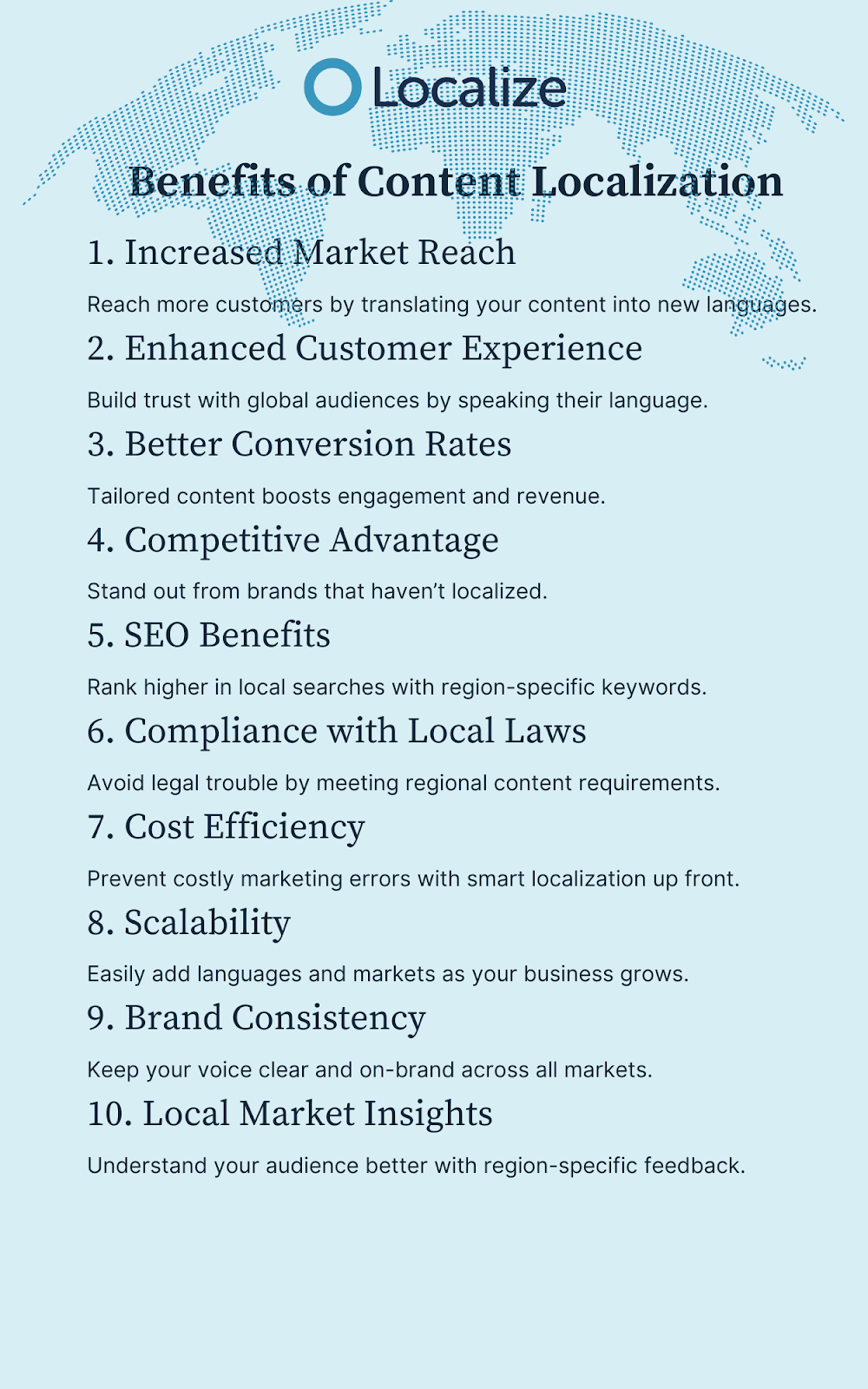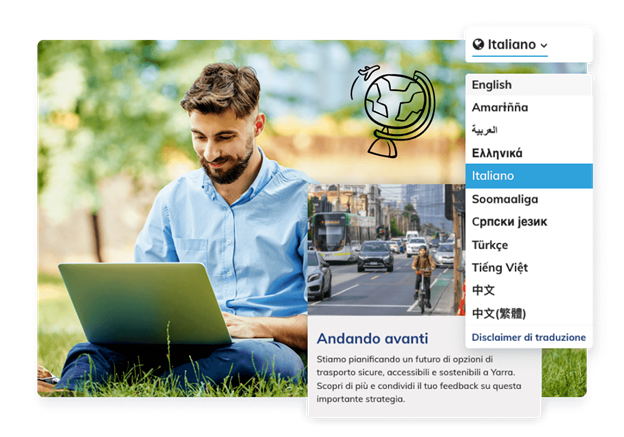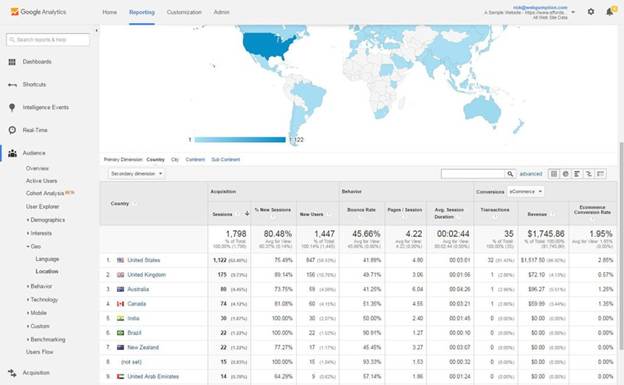Learn about content localization and its crucial role in adapting your message for international markets, enhancing relevance and impact.
.png)

Last year, Reddit made one big change that quadrupled its daily active user base in just a few months. The update? Full-scale content localization of the entire Reddit platform.
All Reddit pages, communities, and forums were translated into 13 languages, with more to come. CEO Steve Huffman shared, “Reddit's goal is to become a more global platform, and one of the reasons for its growth is its increased focus on AI translation and content localization." The investment has paid off so far, with revenues outside of the US surging 82%.
Thanks to advances in AI translation, content localization isn’t just for tech giants like Reddit anymore. It’s now faster, more accurate, and more affordable, making it a smart strategy for companies of all sizes.
Content localization is the process of adapting content to meet a new market's cultural, linguistic, and functional requirements.
It’s more than translating text; it also includes modifying design, imagery, formats, and cultural references to ensure that everything resonates with local users.
The goal of content localization is to create a seamless and relevant user experience that aligns with local customs, norms, and expectations. The end goal? Boosting engagement and satisfaction in different regions.

“[Localization] is our best shot at dramatically accelerating our growth outside the U.S. in the non-English market.”
-Steve Huffman, CEO of Reddit
In 2024, Reddit launched a new content localization strategy: providing AI translations to Redditors all over the world.

With the click of a button, users can translate their entire feed, including posts and comments, and participate in conversations in their own language. Local moderators also play a crucial role in curating content that reflects regional interests, humor, and preferences.
Reddit’s CEO, Steve Huffman shared, “This represents our best shot at dramatically accelerating our growth outside the U.S. in the non-English markets.” After significantly increasing their user base and boosting revenue by 82%, it looks like he’s right.

In 2025, ContractPodAI, a SaaS company in the legal field, set out to localize its cloud platform.
With legal teams around the world relying on ContractPodAI to manage documents, contracts, and workflows, accurate and efficient localization was essential. After selecting Localize as their translation management system, the team reduced costs and delivered high-quality translations in dozens of languages.
Product Manager Tessa Kilbride shared, “We have been able to rapidly expand our business into multiple languages...” After the multilingual launch, traffic surged by 31,000 visits.
Recently, Social Pinpoint set out to help its clients serve multilingual communities more effectively. Known for its digital engagement platform, the company needed a translation solution that could support dynamic, community-created content in 14+ languages, without adding technical burden.

Chief Product Officer Brian Ashton shared, “Our motivation for adding translation was driven by our DEI goals—ensuring an inclusive and equitable experience across all of our customers and communities.”
Since debuting their content localization project, Social Pinpoint has seen a 70% client adoption rate and higher levels of engagement across hundreds of communities.
Expanding into global markets presents unique challenges for businesses, particularly when it comes to effectively engaging diverse audiences. Many companies struggle to adapt their content to resonate with different cultural and linguistic contexts, often leading to missed opportunities and diminished customer engagement.

An effective content localization strategy is the key to overcoming these challenges. It enables businesses to deliver relevant and culturally appropriate content that fosters stronger connections with international audiences.
Content localization strategy is the blueprint that guides your efforts to reach international audiences. It helps you systematically approach localization and maximize the impact of your content on a global scale.
Taking your content global requires a well-defined process. Let's break down the key steps involved in content localization strategy:
Localization can be an investment, so it’s important to focus on content strategy before you begin translating. Let’s explore four key components of planning a successful content localization strategy.
The first step in planning your localization strategy is deciding which locales to target and what languages to include.
So, what’s the best way to get started? Here’s what we recommend:
Website analytics can uncover untapped markets that might need multilingual websites. Many online platforms like Google, YouTube, LinkedIn, Meta, and Twitter have built-in analytics. Use this data to sort and filter your audience by location. For example, you can use Google Analytics to find out details about your international audience:

As you view your data, here are some important questions to ask:
Research to find out if your product or site is a good fit for a local market. The best market for your content will depend on what you’re offering to consumers. Here are some interesting examples of consumer preferences from top markets around the globe:
Start small and scale your efforts.
Generally, you should expand your content into a few new locales at a time and scale from there. As you develop your approach, use style guides and glossaries to take plenty of notes on cultural nuances, jargon, and market-specific differences. Cultural sensitivities, preferences, and consumer trends will vary depending on the target market.
After you decide who to target, it’s time to figure out what content you want to localize for your new audience. You can localize anything, from websites to apps and social media posts.
It’s typically best to start with your most popular content and scale from there. Localizing existing content is much more affordable than creating new international content from scratch.
When translating a website, for example, you should think about localizing all relevant content in the customer experience:
Next, decide which tools you’ll use to manage localization. Free AI translation tools might seem appealing, but they often produce low-quality results. AI tools like Google Translate are prone to context errors, awkward phrasing, and formatting issues.
Instead, use a translation management system (TMS) like Localize. A TMS combines fast, affordable AI translation with human review so your content stays accurate, natural, and culturally relevant.
The right TMS will streamline your workflow, from translation to content updates to publishing. Look for one that integrates with platforms you already use, such as WordPress, Shopify, Wix, Squarespace, or Salesforce.
Advanced systems also offer automated content detection and delivery, eliminating the need for manual file uploads. This is especially useful for high-volume, fast-changing content like eCommerce catalogs, SaaS product marketing pages, or internal tools.
After you localize your content, it’s time to see how well it’s doing. Measuring the ROI of your efforts can help convince stakeholders to continue investing in localization.
Many brands use data tools like Google Analytics to get a high-level overview of their translation metrics. Data often shows that localization can set your brand up for continued growth and success.
Here are a few questions that can help you measure the success of your content localization strategy:
Here are some more tips to assist you during the localization planning process.
Humanize Your Localization Efforts
Effective localization means developing consumer trust as you enter a new market. A few grammatical or idiomatic errors might seem like no big deal, but you could risk offending your potential customers or losing their trust.
Cultural nuance matters, and it varies across the globe. For example:
Similarly, you should pay attention to how you expect your customers to pay for their purchases. Credit/debit cards and bank transfers can work in different ways in other countries.
For example:
Anticipate Localization Needs Before Design and Development
Ideally, planning for localization should begin before the initial design phase. Successful localization aims to make your audience feel that your business is coming from their local market. This starts with an empathetic design. Your website should be designed with other languages in mind. For example:
Document Your Brand
Your content localization strategy should align with your brand. The best way to ensure this is by documenting your brand and marketing strategy. If you don’t already have a style guide, you should create one. It should include the following information:
Involve Your Whole Team
Planning for localization should include training on aspects of your new markets, along with how to use the localization tools you choose. Your entire team needs to be part of your localization planning, including:
Content localization is a crucial strategy for businesses aiming to thrive in global markets. By adapting content to meet the cultural and linguistic needs of different regions, companies can enhance user experience, increase customer engagement, and drive international growth.
Localize offers a powerful solution to simplify and optimize the content localization process. Here's why Localize is the ideal partner for your localization needs:
Localize provides a comprehensive, user-friendly solution to meet your content localization needs. It helps you effectively engage international audiences and achieve sustained global success. Enhance your business’s international presence with Localize’s innovative and efficient translation tools.

Brandon Paton, CEO and founder of Localize, is dedicated to helping businesses extend their global reach through impactful localization strategies. His leadership drives Localize's mission to empower companies in managing multilingual content, enhancing their international presence and customer engagement.
Transform your event management journey from concept to analysis with Releventful. Elevate each step with our comprehensive tools designed for unforgettable event experiences.
Explore our features now!